 Facebook
Facebook
 X
X
 Instagram
Instagram
 TikTok
TikTok
 Youtube
Youtube
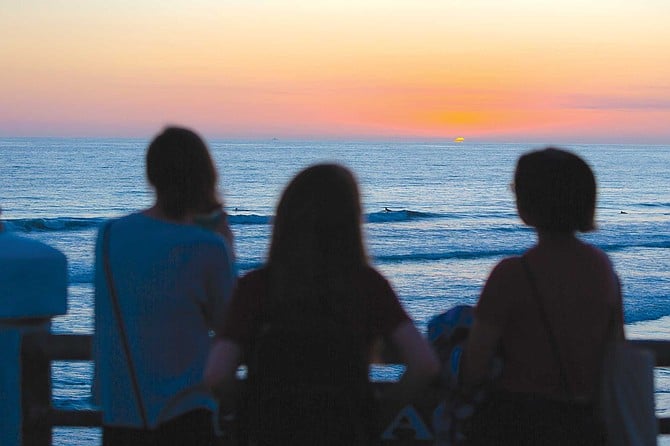
From the moment we spotted the billboard proudly shouting: “Oceanside, California’s Best Kept Secret,” as we wheeled in from L.A. on southbound Highway 101, my brother Dave and I were frothing. Crossing that imaginary line meant we would be surfing the pier within minutes, even before the car was unpacked.

The year was 1965, and just as they had the previous two Augusts, my parents rented one of Robert’s Cottages, those pink dollhouses planted in the sand just south of the pier, somehow avoiding McMansionization to remain as humbly quaint as ever. Dad repeatedly told us to take care of the place, because he was paying $100 a week and needed to get his $25.00 cleaning deposit back. Still, we somehow managed to track in playgrounds of sand each day after riding good and often empty surf steps from the front door.
Big days would come years later, sitting terrified in the shadow of those barnacle-encrusted pilings as late summer Chubasco swells shook the pier with each breaking wave. This was the home to famous surfers Phil Edwards, L.J. Richards, and the late “Little” Petey Johnson, famous for riding the heavies in Hawaii at age 13. Everybody in town left their boards at Petey’s semi-Victorian house overlooking the pier, next door to the place that would be made famous by the movie Top Gun.
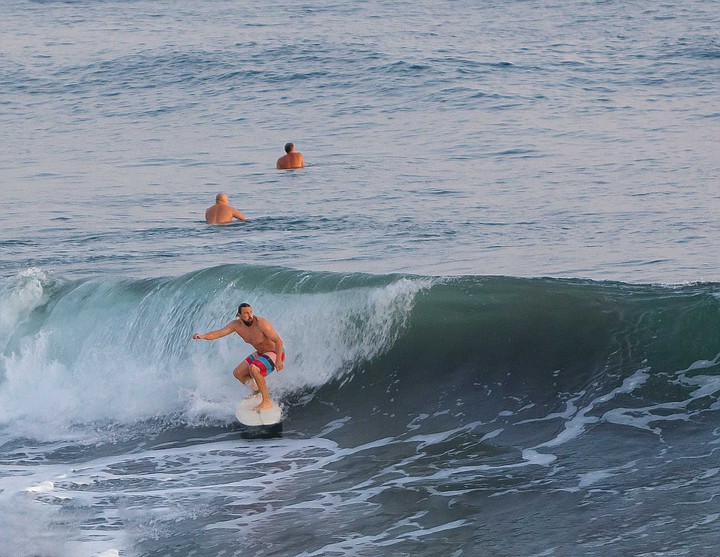
There was never anything fancy about Oceanside. It was unpretentious and so fit our family perfectly. It still does, to the point where my wife and I moved there a year and a half ago.
Camp Pendleton Marine Base provides a 17-mile greenbelt separating it from Orange County, and Oceanside once resembled a hip but seedy border town, complete with adult bookstores, strip clubs, gun shops, pawnshops, and a hardcore underground biker and surf culture. Depending on your POV, Oceanside has either been cleaned up or overly sanitized.

Within its 41 square miles are three major shopping malls, six golf courses, three 1950s movie houses, three modern megaplex theaters, about half a dozen auto salvage yards, the King of the California Missions, a dozen or so museums (including one dedicated strictly to tattoos), dozens of tattoo parlors, a boat harbor, a sports complex boasting 22 soccer fields, and three and a half miles of surfable coastline. All this serving a population hovering around 180,000, which swells to roughly ten times that number during the tourist days of summer.
San Luis Rey Valley
Two miles east on Highway 76 from Oceanside Pier lies a small airport bordered on two sides by the industrial heart of the city. The drab ‘60s-style complex contains an uncountable number of auto repair shops, two breweries, a handful of inexpensive Mexican restaurants, the biggest steel guitar store this side of Nashville, and one of the nation’s largest surfboard building centers. If you ride a domestically made surfboard, chances are good it was born under the Linden, Hawaiian Pro Designs, Superbrand, Pyzel, Channel Islands, Epoxy Pro, Vulcan, Global, Byzak, Turbo, Lab, or Chemistry labels, all of which reside in Oceanside’s San Luis Rey Valley. Many of the foam blanks used to make these surfboards also pass through Oceanside, via Arctic Foam. These board makers help supply fresh handmade sticks to Coast Highway surf establishments from the boutique Real Surf Shop to the department store-sized Surf Ride.
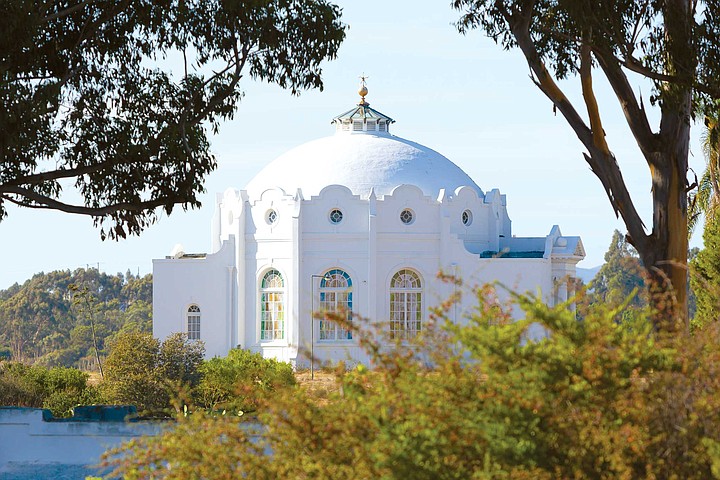
Directly to the south and east of the industrial park is the Oceanside Municipal Airport. Cute little Piper Cubs and Cessnas line the runways before belting out throaty rhythms reminiscent of ancient TV shows like the 1950s hit Sky King, or the 1980s’ Fantasy Island. Flight lessons run around $150, which is roughly the cost of a one-way trip to 12,500 feet followed by a 120-miles-per-hour plunge to earth. Men, women, and children participate in these harrowing tandem jumps through GoJump. Judging by the number of beaming faces afterward, the rush from the drop lingers well after reconnecting with terra firma. GoJump employee Chris Rohbeck, who has accomplished 30 jumps and hopes to one day become an instructor, says, “It’s not normal to jump out of a plane, and for some people it can cause sensory overload. I’ve seen people pass out on the tarmac and others throwing up. It’s not for everybody.”
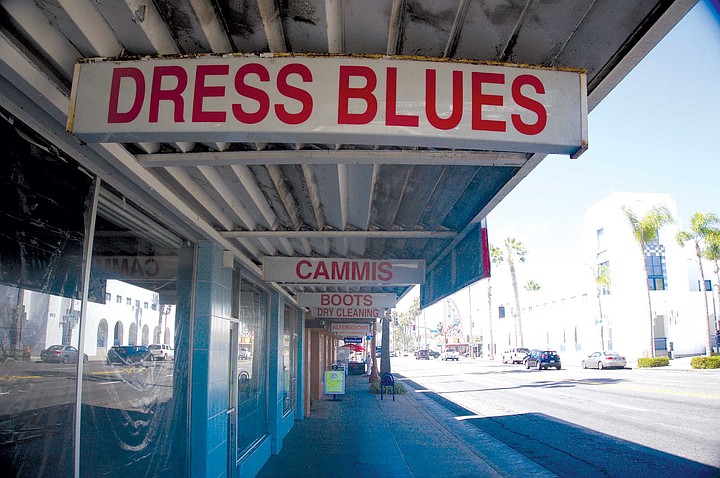
Vanessa and Anita decided to take the leap on a recent Friday afternoon. Anita said, “We work together at the Scripps Cancer Center and wanted to celebrate life. It was awesome.” Both women said they would gladly take the drop again.
Just east of the airport lies a massive dirt lot surrounded by a ribbon of tell-tale orange, plastic fencing, and what was once the Valley Drive-In. Unable to anticipate the coming home entertainment boom, Valley owners couldn’t sell enough movie tickets or popcorn to keep the 1960s landmark afloat in an era when land values soared from thousands to millions per acre.
North of the airport is a free skate park on the banks of the San Luis Rey River; a bike path gently winds for 10.7 miles along the riverbanks.
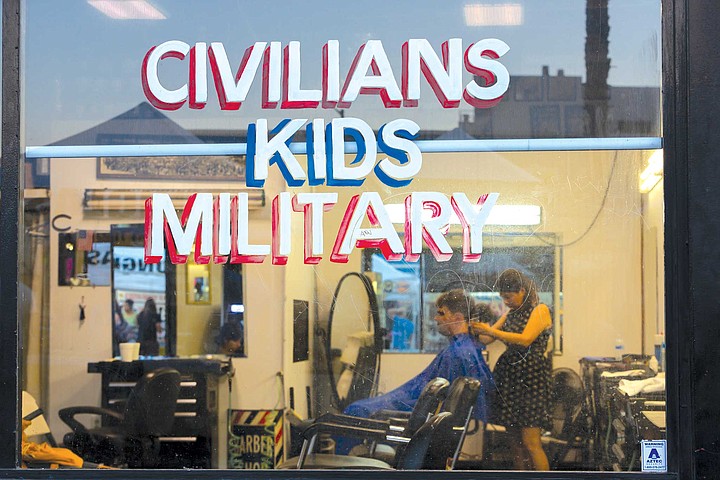
Valley Drive-In first rolled film in 1966 and their last picture show faded to black in 1999. The property then became the exclusive home of one of San Diego County’s finest swap meets. The meet filled in the nostalgia gap left in the wake of the demolished theater by featuring authentic huarache sandals, collectible Fender guitars, surfboards, and original Logan Earth ski decks. Decent and inexpensive Mexican food and a rich cross-cultural experience rarely found without a passport both came with the two-dollar admission.
Actually, the swap meet had been in operation for over a decade by the time the last teenager stowed away in a friend’s trunk in the hopes of catching The Spy Who Shagged Me gratis. Like all things funky, the lower classes tended to love the drive-in and freewheeling bazaar, while some developers tended toward snide references to it as either an eyesore or an economic wasteland.
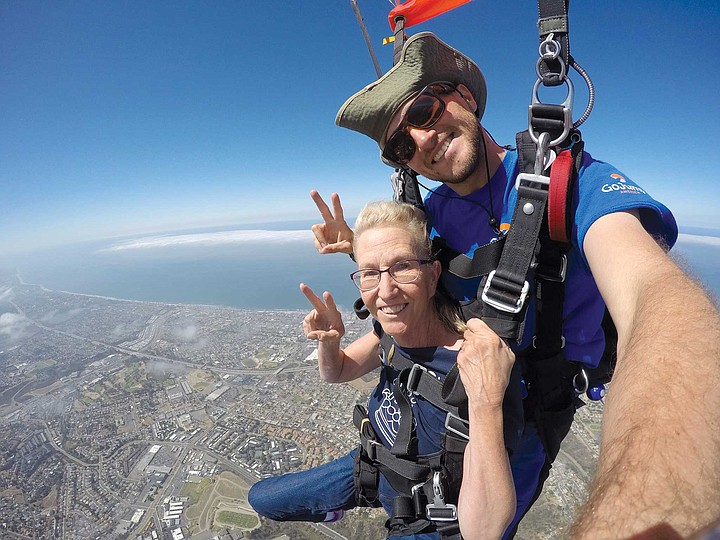
By May 2019, anything resembling 1960s Mexican/hippie chic had been ground back into the dust on which it had been erected. As of this writing, nothing is certain, but there are serious discussions concerning 700 houses, some upscale restaurants, a hotel, a BMX track, a rock-climbing wall, and a 35-acre surfing park, all hoping to make literal or figurative waves on the land.
While wave machines have become popular inland, many wonder at the point of pay-per-tubes within two miles of Oceanside’s three-star (out of a possible five) beach breaks. While nobody I spoke to vehemently objected to the artificial wave, some surfers questioned the need for it. Among them was local surfer Tracy La Rue, who said, “I surf every day for free; why would I pay to ride smaller waves?” Others, such as longtime Oceanside bodyboarder Joe Kim, are more enthusiastic, saying, “It’s like we’re snowboarders riding Big Bear all our lives when someone offers to build the Alps next door.”
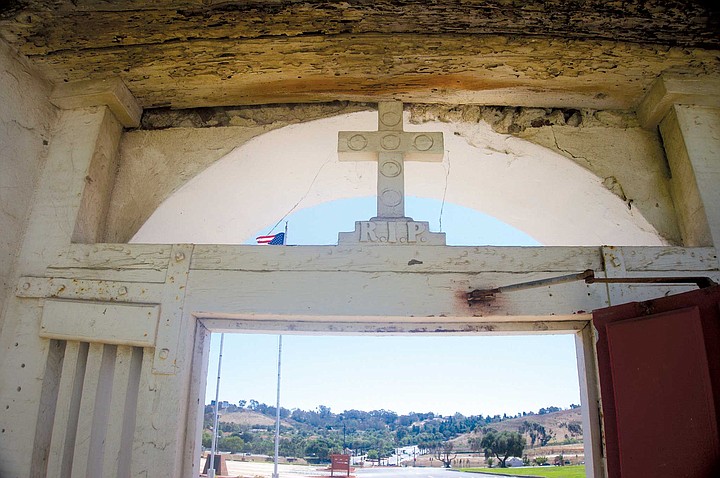
Opinion aside, if the coming waves resemble those at Kelly Slater’s Surf Ranch in Lemoore, California, Oceanside could soon be pumping out better surf than anything in San Diego County. Another plus for artificial waves is that they are unaffected by tidal shifts, and the onshore winds that tend to plague Oceanside most afternoons. While surfing a machine-generated wave costs money, some will find it worth the admission price to avoid possible encounters with jellyfish, stingrays and especially, sharks, whose rare bites and frequent sightings have risen dramatically in the last decade.
Eclecticism reigns in the San Luis Rey Valley: military surplus stores, a library, a smoke shop, a police station, and Killer Pizza From Mars all exist within blocks of each other.
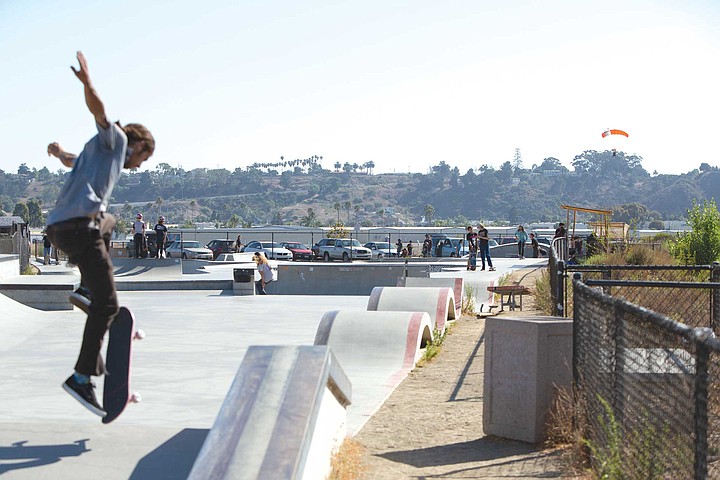
First built in 1798, Mission San Luis Rey de Francia, “The King of the Missions” rests on a fraction of the land it once occupied. Still, 35 acres is quite a spread these days, and the adobe church regally stands watch over the busy thoroughfare named for it, Mission Avenue. As the largest of all the California missions, San Luis Rey continues to function as a Catholic parish. The mission’s museum displays relics from the past while tracing the tension between the Spanish who established the mission and the San Luiseño Band of Indians who built it. Daytime and overnight retreats are available at the mission for a nominal fee.
The Pier
We called it the Oceanside Pier, but the current 1942-foot pier (the longest in California) is actually Oceanside’s sixth such structure. Each previous platform was washed away by powerful storms. When the El Niño storms of 1983 clocked number five, it remained in disrepair until number six opened four years later.
Surfers are split over which has the best surf, the pier or the harbor. A moderate south swell was running at the pier and Australia-born surfer Heath Walker was drying off in the parking lot. According to Walker, “The pier and the harbor are different and both have their days, depending on swell direction and tide. It’s pretty mellow in the lineup, but a lot of local board builders surf the pier and they tend to be a little pissed off by nature. I’ve lived here for 17 years, and I love surfing Oceanside. The waves here aren’t great, but they’re good.”
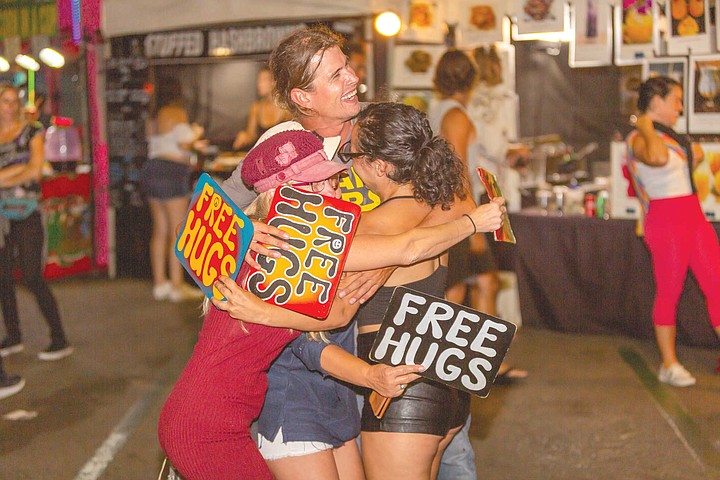
A multifunctional platform, the pier not only serves as a place to fish, but also to catch daily surf action or one of the city’s many aquatic competitions including the World Bodysurfing Championships, The Supergirl Pro, the TikiSwim, or the Oceanside Longboard Surfing Club Contest, an event that has brought surf clubs together from around the world for 35 years.
For years, it was unofficially known as “Donald’s” contest, after Oceanside’s most famous club member, the late Donald Takayama. The greatest of Hawaiian surf legends, Buffalo Keaulana, and Rabbit Kekai joined those who helped redefine our sport on the California coast. Historic figures such as Dale Velzy, Kathy “Gidget” Kohner, Dewey Weber, Phil Edwards, Linda Benson, Joyce Hoffman, and Greg “Da Bull” Noll have all made regular appearances, much to the delight of their many adoring fans, most of whom were still unborn when their heroes were carving out surfing’s future.
Widely considered the best longboarder of his time, now 43-year-old Joel Tudor was dreaming of nothing more than displaying his precocious skills and winning the junior’s division when he first entered the event at age 13. From that first year forward, Tudor amazed legends, judges and all other observers with his brilliant turns and elegant footwork. Another then-anonymous competitor, Robert “Wingnut” Weaver, found his sea legs at Donald’s contest before moving on to co-star in Bruce Brown’s Endless Summer Two. Others to launch surf careers at the annual shindig include Carlsbad councilwoman Cori Schumacher and her mother Jeanette.
The club event continues to ride the wake of Takayama’s love of surfing and a fun party while continuing to live up to their mission statement by “…holding and participating in surfing contests and other surfing related events and engaging in similar activities, either by ourselves or in association with other non-profit organizations to raise funding to promote the heritage, culture and sport of surfing and to protect and preserve our coastal and marine environments.” Even the annual barbecue retains Donald’s mark of excellence.
Hungry beachgoers can also find something worth eating at Ruby’s Diner, comfortably set near the pier’s tip. Ruby’s features breakfast, lunch, and dinner in the American hamburger, fries, and shake tradition while including items such as Chinese chicken salad.
While you are probably safe from whatever the Pacific can throw at you here, late summer often sends deep-south hurricane swells called Chubascos to rock both the pier and you to the foundation. For those not into the walk, there are a variety of bars, grills and family restaurants catering to most any taste within feet of the beach. Closer still is “The Tin Fish,” a restaurant that, partially true to its name, offers fresh seafood beneath the shade of the pilings.
The Junior Seau Amphitheater hosts everything from hip-hop shows to high school graduations. This was once the site of beauty pageants and competitive skateboard freestyle contests where tricks were traded for points and cash. While Junior’s name certainly deserves to be placed here, it could just as easily have been named the Seau/Takayama Amphitheater. The unlikely pairing (Junior was 6’3” 250 pounds; Donald was 5’3”, 130) was built around mutual respect and regularly paddling out to share a peak in front of Junior’s home near Wisconsin Street.
In November of 2012, Takayama’s ashes were scattered near the pier as thousands of those whose lives and boards he shaped, along with famed surfers from as far afield as Australia, paddled out or stopped by to pay their respects.
The Harbor
A little over a mile north of the pier is Oceanside’s south jetty and, depending on who you ask, either the best surf or the second best surf in town. According to Maka, a surfer recently transplanted from Hawaii, “I like the harbor, because it’s a consistent wave with lots of good variety. It’s a good wave for everyone from advanced surfers to beginners, and the locals here are pretty chill.”
The sandy shoreline, wide beach, palapa, and children’s playground make it perfect for family outings. While picnics are the norm here, one of the many waterfront restaurants is another option.
In contrast to the pier, which generally yields little more than pan-sized mackerel, white seabass, yellowtail, and the rare tuna, bigger fish can be reeled in on the boats that exit the harbor daily. Sandra O’Brien Ingle of Halgren’s Sport Fishing says, “We began doing fishing trips in 1978, and we continue to do everything from half-day trips — which usually yield fish like bass, halibut, and sculpin — to two-and-a-half-day trips, which go into Baja targeting bigger fish like tuna. The fishing this year was good, but it could always be better, right?”
Arthur has worked the counter at Boat Rentals of America for the past 18 years. According to him, “Everyone from Oceanside locals to people from as far away as France, Germany, and Switzerland come here to rent boats and kayaks. For those desiring a workout while remaining closer to shore, kayaks, stand-up paddleboards, and pedalboats are the way to go. If you want to explore outside the harbor, we also rent powerboats, sailboats and waverunners.”
Directly north of the harbor mouth is an untracked 17 miles of beach kept under the watchful eyes of Camp Pendleton’s United States Marines. While the best waves form at Del Mar Jetty, or DMJ as it is often known, there are lesser-known spots for those willing to take a short boat ride.
There are a limited number of paid parking spaces near the south jetty, and a large number of free parking stalls two blocks from shore.
Downtown & Coast Highway
Those of us born in big cities might cringe upon hearing the term “urban renewal.” The idea to clean up blighted areas is fueled, no doubt, by the best intentions. Yet this is sometimes as effective as trying to kill a flea on a dog with a shotgun. The flea may die, but the dog, if it survives, will never be the same. Point is, many of the old places get lost amid the do-gooding. It’s happened all over the country. Believing that Oceanside wouldn’t fare any better, I steered clear of the revamped downtown for years. I assumed it would be the latest example of the blind wrecking ball operator shattering souls along with concrete.
On Thursday, September 5, I accompanied two friends downtown to visit the farmer’s market, holding out the vague hope of being wrong. All sorts of people from all kinds of backgrounds danced in the streets, silently answering Rodney King’s question in the affirmative. It’s like a relatively sober Mardi Gras minus the scary costumes and voodoo priests. The cover band on stage and the man playing tenor sax near the pier, free hugs given by the young and the beautiful to anyone willing to “bring it in,” fresh organic fruits and vegetables and non-aggressive proselytizers all seem to work together for the good.
Once known as Hill Street, this perfectly flat stretch of pavement hugging the coast through Oceanside is now appropriately called Coast Highway. The name changed long before the facelift given to the pier area. Small storefronts that once sold mattresses and repossessed furniture have been reborn as non-chain restaurants while standing clear of the shadows of the new high-rises.
Wander a few blocks from the path and you will find old Oceanside in full bloom: a bowling alley, breakfast nooks worthy of Fonzie, a series of used car lots, a warehouse-sized second-hand store, and a graveyard. Kudos to the Oceanside City Council for keeping Big Macs and 7-11s off the street and allowing Angelo’s Burgers, Cream of the Crop, and the newly refurbished Moose Lodge a shot at making it.
Close friends Brenda and Brande live adjacent to Oceanside in Carlsbad, but visit Oceanside with greater frequency these days. According to Brande, “There’s a lot of new development, but once you get to the beach, it’s the same as it’s always been. I love it here. It can be a little edgy at times, and that’s okay — Oceanside’s always going to be the spicy part of North County.”
Overdelivering on its name, the California Surf Museum displays international surf items. Ancient wooden surf craft line the ceiling and walls, along with early foam and late '60s to mid-'70s transitional shortboards. Perhaps chief among the museum’s gems, however, is a fiberglass shortboard with little to distinguish it other than a crescent-shaped chunk gouged from the rail. This board was made famous after a tiger shark bit into it and took Bethany Hamilton-Dirks’ left arm in the brutal process. Hamilton-Dirks is among the most popular surfers to be featured at the museum. Others to make speaking appearances include Pipeline Master Gerry Lopez, Australian World Champion Nat Young, and Encinitas-raised Linda Benson, whose numerous aquatic feats include being the first woman on record to ride Hawaii’s Waimea Bay.
The co-founder of the museum, Jane Schmauss, inadvertently started the museum by gathering old discarded surfboards to display on the ceiling of George’s, a small breakfast joint she once owned and operated on Coast Highway in Encinitas. Jane, who is not a surfer, found value in the relics, and perhaps even more in the surf stories told by the famous surfers who visited. Big-timers such as Don Hansen, Mike Doyle, Rusty Miller, Linda Benson, Pat Curren, and the Ekstrom brothers became regular customers and told tales that breathed new life back into the old surfboards.
After Schmauss was contacted by Encinitas-based architect Stuart Resor, the California Surf Museum staggered to its feet and eventually found a home in Oceanside, first on Coast Highway then at its current location, 312 Pier View Avenue. Five bucks for adults, three for seniors and one for kids gets you in the door. Already a deal, it’s possible to get far more than you bargained for as one of many history-making surfers is likely to be hanging out, ready to offer a free living history lesson.
Museum exhibits rotate regularly, and benchmark surfboards such as the one that belonged to Hawaiian surfing dignitary Eddie Aikau before he paddled away in an attempt to rescue his crewmates aboard the sinking Hokule’a. Like surfing itself, the museum is a laid back, friendly affair where marine science and surf history mix like saltwater and fiberglass.
Having worked in Oceanside for nearly three decades, Schmauss has mixed feelings about redevelopment. According to her, “The California Surf Museum came to Oceanside in 1991, and we’ve certainly witnessed some incredible growth and changes. Oceanside is wise to try and concentrate unique cultural attractions in the walkable downtown area, but we’ve also lost the large parking lots that were convenient for both employees and visitors. Since early this year, parking has been very tight, and we’re not seeing the steady stream of folks on the sidewalks.”
While few Oceanside structures topped two stories in the recent past, the most prominent fixtures near the pier these days are towering cranes as they erect high-rise luxury apartments overlooking the sea. The question often debated by residents is: did we pave paradise or level a slum? June Jimenez, a former Oceanside High School sports star who graduated in 2000 isn’t sure. Without the least hint of bitterness, he recalls his teen years, saying, “We used to be able to run [the six blocks from Oceanside High] down to the pier without going through all the obstacles put up by the new buildings. My kids won’t have what we had.”
It’s somehow reassuring to see “no skateboarding” signs being ignored, and few seem to mind residents passing beneath the golden arch leading into the city on foot or wheels. The Civic Center features all the departments necessary to run a mid-sized town, a beautiful library and an art museum with greater depth than one might expect to find in a small town this size.
Not exactly a museum, but a place echoing with historic tales worth telling, Red Rooster off Oceanside Boulevard serves mouth-watering chiliburgers and cold draft beer. Here, surfers of all ages shoot pool with Vietnam vets (who are often the same people), hearing stories of war and waves so big you could bump your head trying to shoot the pier.


From the moment we spotted the billboard proudly shouting: “Oceanside, California’s Best Kept Secret,” as we wheeled in from L.A. on southbound Highway 101, my brother Dave and I were frothing. Crossing that imaginary line meant we would be surfing the pier within minutes, even before the car was unpacked.

The year was 1965, and just as they had the previous two Augusts, my parents rented one of Robert’s Cottages, those pink dollhouses planted in the sand just south of the pier, somehow avoiding McMansionization to remain as humbly quaint as ever. Dad repeatedly told us to take care of the place, because he was paying $100 a week and needed to get his $25.00 cleaning deposit back. Still, we somehow managed to track in playgrounds of sand each day after riding good and often empty surf steps from the front door.
Big days would come years later, sitting terrified in the shadow of those barnacle-encrusted pilings as late summer Chubasco swells shook the pier with each breaking wave. This was the home to famous surfers Phil Edwards, L.J. Richards, and the late “Little” Petey Johnson, famous for riding the heavies in Hawaii at age 13. Everybody in town left their boards at Petey’s semi-Victorian house overlooking the pier, next door to the place that would be made famous by the movie Top Gun.

There was never anything fancy about Oceanside. It was unpretentious and so fit our family perfectly. It still does, to the point where my wife and I moved there a year and a half ago.
Camp Pendleton Marine Base provides a 17-mile greenbelt separating it from Orange County, and Oceanside once resembled a hip but seedy border town, complete with adult bookstores, strip clubs, gun shops, pawnshops, and a hardcore underground biker and surf culture. Depending on your POV, Oceanside has either been cleaned up or overly sanitized.

Within its 41 square miles are three major shopping malls, six golf courses, three 1950s movie houses, three modern megaplex theaters, about half a dozen auto salvage yards, the King of the California Missions, a dozen or so museums (including one dedicated strictly to tattoos), dozens of tattoo parlors, a boat harbor, a sports complex boasting 22 soccer fields, and three and a half miles of surfable coastline. All this serving a population hovering around 180,000, which swells to roughly ten times that number during the tourist days of summer.
San Luis Rey Valley
Two miles east on Highway 76 from Oceanside Pier lies a small airport bordered on two sides by the industrial heart of the city. The drab ‘60s-style complex contains an uncountable number of auto repair shops, two breweries, a handful of inexpensive Mexican restaurants, the biggest steel guitar store this side of Nashville, and one of the nation’s largest surfboard building centers. If you ride a domestically made surfboard, chances are good it was born under the Linden, Hawaiian Pro Designs, Superbrand, Pyzel, Channel Islands, Epoxy Pro, Vulcan, Global, Byzak, Turbo, Lab, or Chemistry labels, all of which reside in Oceanside’s San Luis Rey Valley. Many of the foam blanks used to make these surfboards also pass through Oceanside, via Arctic Foam. These board makers help supply fresh handmade sticks to Coast Highway surf establishments from the boutique Real Surf Shop to the department store-sized Surf Ride.

Directly to the south and east of the industrial park is the Oceanside Municipal Airport. Cute little Piper Cubs and Cessnas line the runways before belting out throaty rhythms reminiscent of ancient TV shows like the 1950s hit Sky King, or the 1980s’ Fantasy Island. Flight lessons run around $150, which is roughly the cost of a one-way trip to 12,500 feet followed by a 120-miles-per-hour plunge to earth. Men, women, and children participate in these harrowing tandem jumps through GoJump. Judging by the number of beaming faces afterward, the rush from the drop lingers well after reconnecting with terra firma. GoJump employee Chris Rohbeck, who has accomplished 30 jumps and hopes to one day become an instructor, says, “It’s not normal to jump out of a plane, and for some people it can cause sensory overload. I’ve seen people pass out on the tarmac and others throwing up. It’s not for everybody.”

Vanessa and Anita decided to take the leap on a recent Friday afternoon. Anita said, “We work together at the Scripps Cancer Center and wanted to celebrate life. It was awesome.” Both women said they would gladly take the drop again.
Just east of the airport lies a massive dirt lot surrounded by a ribbon of tell-tale orange, plastic fencing, and what was once the Valley Drive-In. Unable to anticipate the coming home entertainment boom, Valley owners couldn’t sell enough movie tickets or popcorn to keep the 1960s landmark afloat in an era when land values soared from thousands to millions per acre.
North of the airport is a free skate park on the banks of the San Luis Rey River; a bike path gently winds for 10.7 miles along the riverbanks.

Valley Drive-In first rolled film in 1966 and their last picture show faded to black in 1999. The property then became the exclusive home of one of San Diego County’s finest swap meets. The meet filled in the nostalgia gap left in the wake of the demolished theater by featuring authentic huarache sandals, collectible Fender guitars, surfboards, and original Logan Earth ski decks. Decent and inexpensive Mexican food and a rich cross-cultural experience rarely found without a passport both came with the two-dollar admission.
Actually, the swap meet had been in operation for over a decade by the time the last teenager stowed away in a friend’s trunk in the hopes of catching The Spy Who Shagged Me gratis. Like all things funky, the lower classes tended to love the drive-in and freewheeling bazaar, while some developers tended toward snide references to it as either an eyesore or an economic wasteland.

By May 2019, anything resembling 1960s Mexican/hippie chic had been ground back into the dust on which it had been erected. As of this writing, nothing is certain, but there are serious discussions concerning 700 houses, some upscale restaurants, a hotel, a BMX track, a rock-climbing wall, and a 35-acre surfing park, all hoping to make literal or figurative waves on the land.
While wave machines have become popular inland, many wonder at the point of pay-per-tubes within two miles of Oceanside’s three-star (out of a possible five) beach breaks. While nobody I spoke to vehemently objected to the artificial wave, some surfers questioned the need for it. Among them was local surfer Tracy La Rue, who said, “I surf every day for free; why would I pay to ride smaller waves?” Others, such as longtime Oceanside bodyboarder Joe Kim, are more enthusiastic, saying, “It’s like we’re snowboarders riding Big Bear all our lives when someone offers to build the Alps next door.”

Opinion aside, if the coming waves resemble those at Kelly Slater’s Surf Ranch in Lemoore, California, Oceanside could soon be pumping out better surf than anything in San Diego County. Another plus for artificial waves is that they are unaffected by tidal shifts, and the onshore winds that tend to plague Oceanside most afternoons. While surfing a machine-generated wave costs money, some will find it worth the admission price to avoid possible encounters with jellyfish, stingrays and especially, sharks, whose rare bites and frequent sightings have risen dramatically in the last decade.
Eclecticism reigns in the San Luis Rey Valley: military surplus stores, a library, a smoke shop, a police station, and Killer Pizza From Mars all exist within blocks of each other.

First built in 1798, Mission San Luis Rey de Francia, “The King of the Missions” rests on a fraction of the land it once occupied. Still, 35 acres is quite a spread these days, and the adobe church regally stands watch over the busy thoroughfare named for it, Mission Avenue. As the largest of all the California missions, San Luis Rey continues to function as a Catholic parish. The mission’s museum displays relics from the past while tracing the tension between the Spanish who established the mission and the San Luiseño Band of Indians who built it. Daytime and overnight retreats are available at the mission for a nominal fee.
The Pier
We called it the Oceanside Pier, but the current 1942-foot pier (the longest in California) is actually Oceanside’s sixth such structure. Each previous platform was washed away by powerful storms. When the El Niño storms of 1983 clocked number five, it remained in disrepair until number six opened four years later.
Surfers are split over which has the best surf, the pier or the harbor. A moderate south swell was running at the pier and Australia-born surfer Heath Walker was drying off in the parking lot. According to Walker, “The pier and the harbor are different and both have their days, depending on swell direction and tide. It’s pretty mellow in the lineup, but a lot of local board builders surf the pier and they tend to be a little pissed off by nature. I’ve lived here for 17 years, and I love surfing Oceanside. The waves here aren’t great, but they’re good.”

A multifunctional platform, the pier not only serves as a place to fish, but also to catch daily surf action or one of the city’s many aquatic competitions including the World Bodysurfing Championships, The Supergirl Pro, the TikiSwim, or the Oceanside Longboard Surfing Club Contest, an event that has brought surf clubs together from around the world for 35 years.
For years, it was unofficially known as “Donald’s” contest, after Oceanside’s most famous club member, the late Donald Takayama. The greatest of Hawaiian surf legends, Buffalo Keaulana, and Rabbit Kekai joined those who helped redefine our sport on the California coast. Historic figures such as Dale Velzy, Kathy “Gidget” Kohner, Dewey Weber, Phil Edwards, Linda Benson, Joyce Hoffman, and Greg “Da Bull” Noll have all made regular appearances, much to the delight of their many adoring fans, most of whom were still unborn when their heroes were carving out surfing’s future.
Widely considered the best longboarder of his time, now 43-year-old Joel Tudor was dreaming of nothing more than displaying his precocious skills and winning the junior’s division when he first entered the event at age 13. From that first year forward, Tudor amazed legends, judges and all other observers with his brilliant turns and elegant footwork. Another then-anonymous competitor, Robert “Wingnut” Weaver, found his sea legs at Donald’s contest before moving on to co-star in Bruce Brown’s Endless Summer Two. Others to launch surf careers at the annual shindig include Carlsbad councilwoman Cori Schumacher and her mother Jeanette.
The club event continues to ride the wake of Takayama’s love of surfing and a fun party while continuing to live up to their mission statement by “…holding and participating in surfing contests and other surfing related events and engaging in similar activities, either by ourselves or in association with other non-profit organizations to raise funding to promote the heritage, culture and sport of surfing and to protect and preserve our coastal and marine environments.” Even the annual barbecue retains Donald’s mark of excellence.
Hungry beachgoers can also find something worth eating at Ruby’s Diner, comfortably set near the pier’s tip. Ruby’s features breakfast, lunch, and dinner in the American hamburger, fries, and shake tradition while including items such as Chinese chicken salad.
While you are probably safe from whatever the Pacific can throw at you here, late summer often sends deep-south hurricane swells called Chubascos to rock both the pier and you to the foundation. For those not into the walk, there are a variety of bars, grills and family restaurants catering to most any taste within feet of the beach. Closer still is “The Tin Fish,” a restaurant that, partially true to its name, offers fresh seafood beneath the shade of the pilings.
The Junior Seau Amphitheater hosts everything from hip-hop shows to high school graduations. This was once the site of beauty pageants and competitive skateboard freestyle contests where tricks were traded for points and cash. While Junior’s name certainly deserves to be placed here, it could just as easily have been named the Seau/Takayama Amphitheater. The unlikely pairing (Junior was 6’3” 250 pounds; Donald was 5’3”, 130) was built around mutual respect and regularly paddling out to share a peak in front of Junior’s home near Wisconsin Street.
In November of 2012, Takayama’s ashes were scattered near the pier as thousands of those whose lives and boards he shaped, along with famed surfers from as far afield as Australia, paddled out or stopped by to pay their respects.
The Harbor
A little over a mile north of the pier is Oceanside’s south jetty and, depending on who you ask, either the best surf or the second best surf in town. According to Maka, a surfer recently transplanted from Hawaii, “I like the harbor, because it’s a consistent wave with lots of good variety. It’s a good wave for everyone from advanced surfers to beginners, and the locals here are pretty chill.”
The sandy shoreline, wide beach, palapa, and children’s playground make it perfect for family outings. While picnics are the norm here, one of the many waterfront restaurants is another option.
In contrast to the pier, which generally yields little more than pan-sized mackerel, white seabass, yellowtail, and the rare tuna, bigger fish can be reeled in on the boats that exit the harbor daily. Sandra O’Brien Ingle of Halgren’s Sport Fishing says, “We began doing fishing trips in 1978, and we continue to do everything from half-day trips — which usually yield fish like bass, halibut, and sculpin — to two-and-a-half-day trips, which go into Baja targeting bigger fish like tuna. The fishing this year was good, but it could always be better, right?”
Arthur has worked the counter at Boat Rentals of America for the past 18 years. According to him, “Everyone from Oceanside locals to people from as far away as France, Germany, and Switzerland come here to rent boats and kayaks. For those desiring a workout while remaining closer to shore, kayaks, stand-up paddleboards, and pedalboats are the way to go. If you want to explore outside the harbor, we also rent powerboats, sailboats and waverunners.”
Directly north of the harbor mouth is an untracked 17 miles of beach kept under the watchful eyes of Camp Pendleton’s United States Marines. While the best waves form at Del Mar Jetty, or DMJ as it is often known, there are lesser-known spots for those willing to take a short boat ride.
There are a limited number of paid parking spaces near the south jetty, and a large number of free parking stalls two blocks from shore.
Downtown & Coast Highway
Those of us born in big cities might cringe upon hearing the term “urban renewal.” The idea to clean up blighted areas is fueled, no doubt, by the best intentions. Yet this is sometimes as effective as trying to kill a flea on a dog with a shotgun. The flea may die, but the dog, if it survives, will never be the same. Point is, many of the old places get lost amid the do-gooding. It’s happened all over the country. Believing that Oceanside wouldn’t fare any better, I steered clear of the revamped downtown for years. I assumed it would be the latest example of the blind wrecking ball operator shattering souls along with concrete.
On Thursday, September 5, I accompanied two friends downtown to visit the farmer’s market, holding out the vague hope of being wrong. All sorts of people from all kinds of backgrounds danced in the streets, silently answering Rodney King’s question in the affirmative. It’s like a relatively sober Mardi Gras minus the scary costumes and voodoo priests. The cover band on stage and the man playing tenor sax near the pier, free hugs given by the young and the beautiful to anyone willing to “bring it in,” fresh organic fruits and vegetables and non-aggressive proselytizers all seem to work together for the good.
Once known as Hill Street, this perfectly flat stretch of pavement hugging the coast through Oceanside is now appropriately called Coast Highway. The name changed long before the facelift given to the pier area. Small storefronts that once sold mattresses and repossessed furniture have been reborn as non-chain restaurants while standing clear of the shadows of the new high-rises.
Wander a few blocks from the path and you will find old Oceanside in full bloom: a bowling alley, breakfast nooks worthy of Fonzie, a series of used car lots, a warehouse-sized second-hand store, and a graveyard. Kudos to the Oceanside City Council for keeping Big Macs and 7-11s off the street and allowing Angelo’s Burgers, Cream of the Crop, and the newly refurbished Moose Lodge a shot at making it.
Close friends Brenda and Brande live adjacent to Oceanside in Carlsbad, but visit Oceanside with greater frequency these days. According to Brande, “There’s a lot of new development, but once you get to the beach, it’s the same as it’s always been. I love it here. It can be a little edgy at times, and that’s okay — Oceanside’s always going to be the spicy part of North County.”
Overdelivering on its name, the California Surf Museum displays international surf items. Ancient wooden surf craft line the ceiling and walls, along with early foam and late '60s to mid-'70s transitional shortboards. Perhaps chief among the museum’s gems, however, is a fiberglass shortboard with little to distinguish it other than a crescent-shaped chunk gouged from the rail. This board was made famous after a tiger shark bit into it and took Bethany Hamilton-Dirks’ left arm in the brutal process. Hamilton-Dirks is among the most popular surfers to be featured at the museum. Others to make speaking appearances include Pipeline Master Gerry Lopez, Australian World Champion Nat Young, and Encinitas-raised Linda Benson, whose numerous aquatic feats include being the first woman on record to ride Hawaii’s Waimea Bay.
The co-founder of the museum, Jane Schmauss, inadvertently started the museum by gathering old discarded surfboards to display on the ceiling of George’s, a small breakfast joint she once owned and operated on Coast Highway in Encinitas. Jane, who is not a surfer, found value in the relics, and perhaps even more in the surf stories told by the famous surfers who visited. Big-timers such as Don Hansen, Mike Doyle, Rusty Miller, Linda Benson, Pat Curren, and the Ekstrom brothers became regular customers and told tales that breathed new life back into the old surfboards.
After Schmauss was contacted by Encinitas-based architect Stuart Resor, the California Surf Museum staggered to its feet and eventually found a home in Oceanside, first on Coast Highway then at its current location, 312 Pier View Avenue. Five bucks for adults, three for seniors and one for kids gets you in the door. Already a deal, it’s possible to get far more than you bargained for as one of many history-making surfers is likely to be hanging out, ready to offer a free living history lesson.
Museum exhibits rotate regularly, and benchmark surfboards such as the one that belonged to Hawaiian surfing dignitary Eddie Aikau before he paddled away in an attempt to rescue his crewmates aboard the sinking Hokule’a. Like surfing itself, the museum is a laid back, friendly affair where marine science and surf history mix like saltwater and fiberglass.
Having worked in Oceanside for nearly three decades, Schmauss has mixed feelings about redevelopment. According to her, “The California Surf Museum came to Oceanside in 1991, and we’ve certainly witnessed some incredible growth and changes. Oceanside is wise to try and concentrate unique cultural attractions in the walkable downtown area, but we’ve also lost the large parking lots that were convenient for both employees and visitors. Since early this year, parking has been very tight, and we’re not seeing the steady stream of folks on the sidewalks.”
While few Oceanside structures topped two stories in the recent past, the most prominent fixtures near the pier these days are towering cranes as they erect high-rise luxury apartments overlooking the sea. The question often debated by residents is: did we pave paradise or level a slum? June Jimenez, a former Oceanside High School sports star who graduated in 2000 isn’t sure. Without the least hint of bitterness, he recalls his teen years, saying, “We used to be able to run [the six blocks from Oceanside High] down to the pier without going through all the obstacles put up by the new buildings. My kids won’t have what we had.”
It’s somehow reassuring to see “no skateboarding” signs being ignored, and few seem to mind residents passing beneath the golden arch leading into the city on foot or wheels. The Civic Center features all the departments necessary to run a mid-sized town, a beautiful library and an art museum with greater depth than one might expect to find in a small town this size.
Not exactly a museum, but a place echoing with historic tales worth telling, Red Rooster off Oceanside Boulevard serves mouth-watering chiliburgers and cold draft beer. Here, surfers of all ages shoot pool with Vietnam vets (who are often the same people), hearing stories of war and waves so big you could bump your head trying to shoot the pier.
Comments